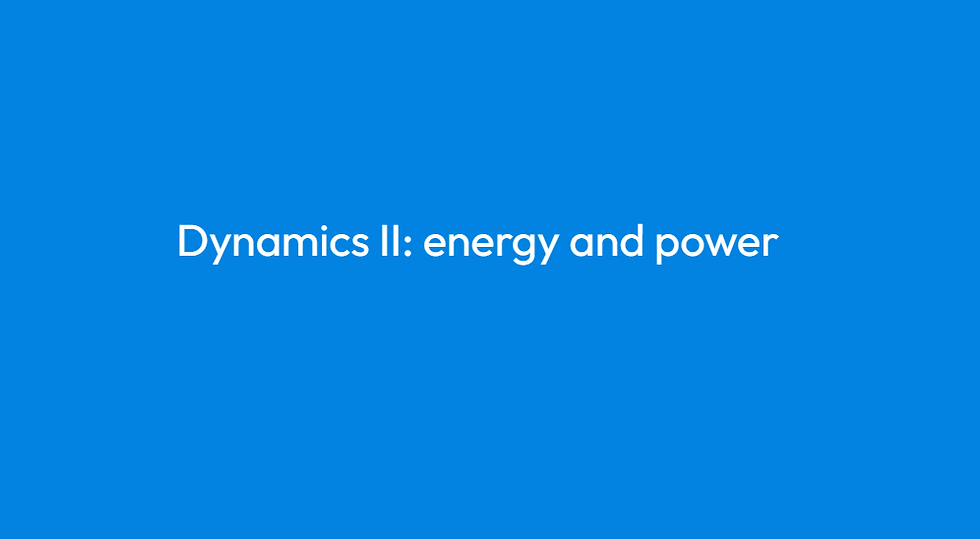Dynamics I: forces and moments
- SEARCH POINT

- Feb 15
- 3 min read

Dynamics I: Forces and Moments
1. Introduction
Dynamics is the study of motion and the forces that cause it. It is essential in biomechanics, engineering, sports science, and rehabilitation. This topic focuses on two key components:
Forces: Push or pull that causes acceleration or deformation.
Moments (Torques): The rotational effect of a force around an axis or point.
Understanding forces and moments helps in analyzing human movement, injury mechanisms, prosthetics, orthopedics, and sports performance.
2. Forces in Biomechanics
a. Types of Forces
Force Type | Description | Example in Human Motion |
External Forces | Forces applied from the environment | Ground reaction force during running |
Internal Forces | Forces generated within the body | Muscle forces acting on bones |
Gravitational Force | Force due to Earth's gravity | Body weight pulling downward |
Frictional Force | Resistance between surfaces in contact | Shoe-ground interaction while walking |
Joint Reaction Force | Force at the joint due to muscle and external loads | Hip joint reaction force during walking |
b. Newton’s Laws of Motion in Biomechanics
First Law (Inertia): A body remains at rest or in uniform motion unless acted upon by an external force (e.g., a runner continues moving unless stopped by friction or muscle braking).
Second Law (F = ma): Force equals mass times acceleration (e.g., greater muscle force leads to faster sprinting).
Third Law (Action-Reaction): Every action has an equal and opposite reaction (e.g., when a person jumps, the ground exerts an equal upward force).
3. Moments (Torques) in Biomechanics
a. Definition of Moment (Torque)
A moment (torque) is the rotational effect of a force about a pivot point or joint.
Moment (M) = Force (F) × Perpendicular Distance (d) from the axis of rotation.
b. Examples in Human Motion
Knee Extension: Quadriceps generate torque to extend the leg.
Elbow Flexion: Biceps apply force at a distance from the elbow, producing a moment.
Ankle Plantarflexion: Calf muscles generate torque to push off the ground in running.
c. Moment Arm and Leverage
Longer moment arms require less force to produce the same torque (e.g., a wrench).
In biomechanics, lever systems determine the efficiency of movement.
Lever Type | Example in the Human Body | Advantage |
First-Class (Fulcrum between Force & Load) | Neck muscles balancing head | Stability & control |
Second-Class (Load between Force & Fulcrum) | Standing on toes (calf muscles) | Strong force advantage |
Third-Class (Force between Load & Fulcrum) | Biceps lifting forearm | Speed & range of motion |
4. Free Body Diagrams (FBDs) in Biomechanics
FBDs visually represent forces and moments acting on the body.
Used in gait analysis, prosthetics, and sports science.
Example: Forces in the Knee Joint During Walking
External forces: Ground reaction force, body weight.
Internal forces: Muscle tension, ligament forces.
Moments: Generated by quadriceps, hamstrings, and ground reaction forces.
5. Applications of Forces and Moments in Biomechanics
Field | Application |
Sports Science | Optimizing force production for performance (e.g., sprinting, weightlifting) |
Injury Prevention | Analyzing excessive forces leading to injuries (e.g., ACL tears) |
Rehabilitation | Designing exercises to restore strength and stability |
Prosthetics & Orthotics | Engineering devices that replicate natural forces and torques |
Ergonomics | Designing workspaces to minimize stress on joints |
6. Conclusion
Forces and moments are fundamental to understanding human movement, injury mechanisms, and performance enhancement. By applying principles from dynamics, biomechanics can improve rehabilitation, optimize athletic training, and enhance prosthetic design, ensuring efficient and injury-free movement.




Comments